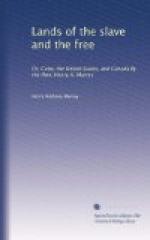A few hours’ run up the river brought us to St. Louis, whose nose, I prophesy, is to be put out of joint by Cairo some future day. Nevertheless, what a wonderful place is this same St. Louis; its rapid increase is almost as extraordinary as that of Cincinnati, and perhaps more so, when you consider, not only that it is further west by hundreds of miles, but that it has to contend with the overflowing of the Mississippi, which has, on more than one occasion, risen to the first floor of the houses and stores built on the edge of the levee; fortunately, the greater part of the town, being built on higher ground, escapes the ruinous periodical duckings. It is situated seven hundred and fifty miles below the falls of St. Anthony, and twelve hundred miles above New Orleans.
Le Clede and his party appreciated the value of its position as early as 1764, and named it in honour of Louis the Fifteenth. Subsequently it was transferred to the Spaniards, in 1768: however, it made but little progress until it passed into the hands of the United States, in 1804. The energy of the American character soon changed the face of affairs, and there are now 3000 steam-boats arriving annually, which I believe to be a greater number than there were inhabitants at the date of its cession to them. But the more active impulse seems to have commenced in 1830, at which time the population was under 7000, since which date it has so rapidly increased, that in 1852 its population was bordering on 100,000. The natives of the United States form about one-half of the community, and those of Germany one-fourth; the remainder are chiefly Irish. There are twenty newspapers, of which four are published in German. There are forty churches, one-fourth of which are Roman Catholic, and a liberal provision is made for education; the material prosperity of this thriving community is evidenced by the fact, that the annual value of the produce of their manufacturing-establishments exceeds 3,000,000l.; flour-mills, sugar refineries, and carpenters, contributing more largely than other occupations; after which come the tailors, thanks probably to the Germans, who appear to have a strong predilection for this trade, at which there are more hands employed than at any other.




